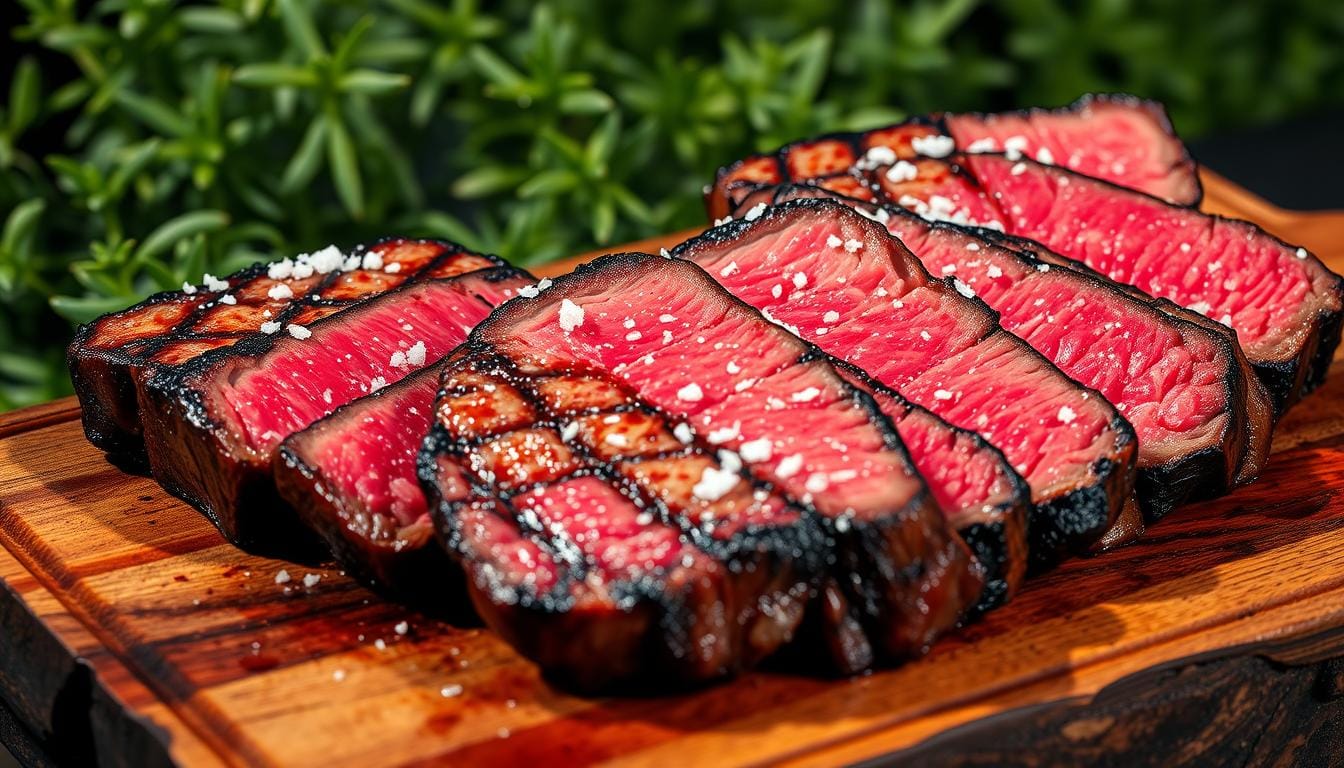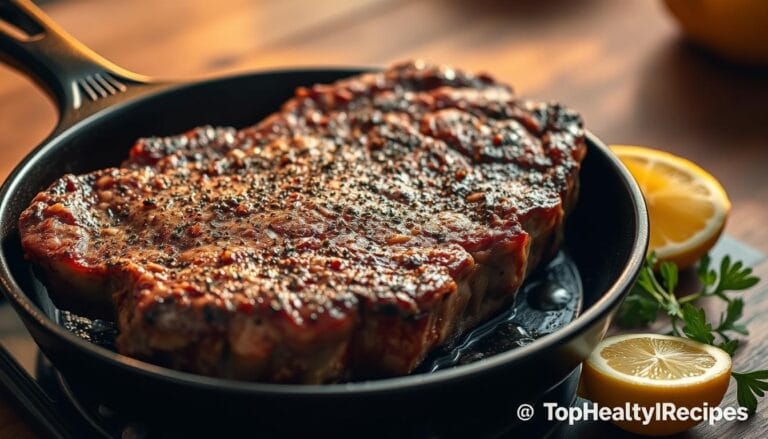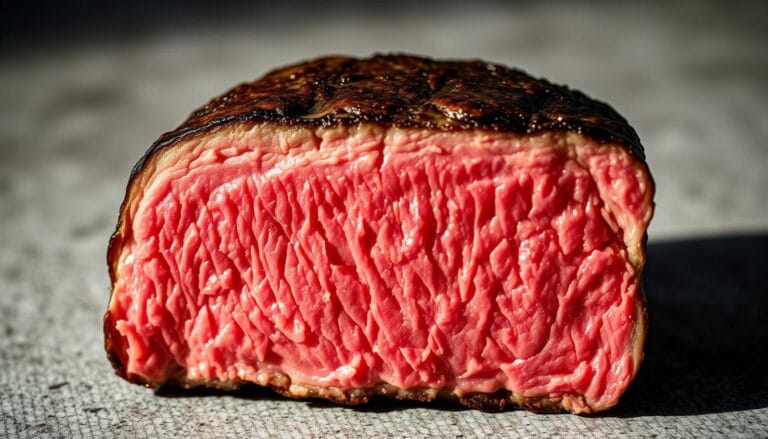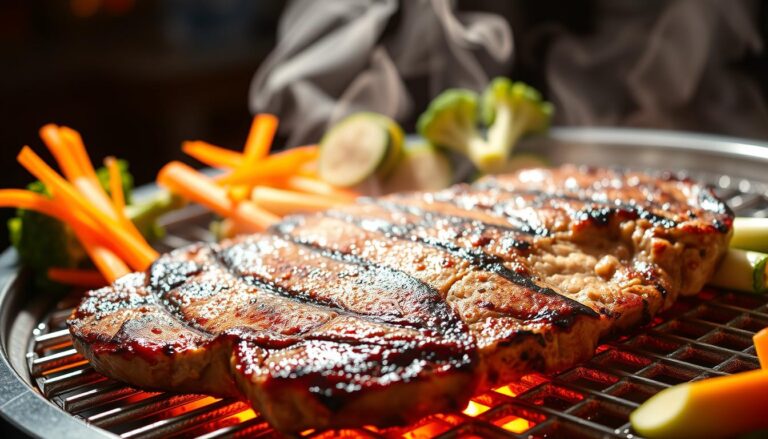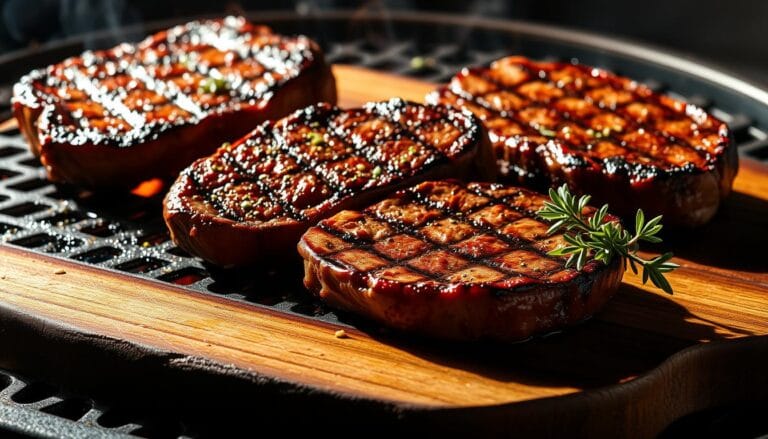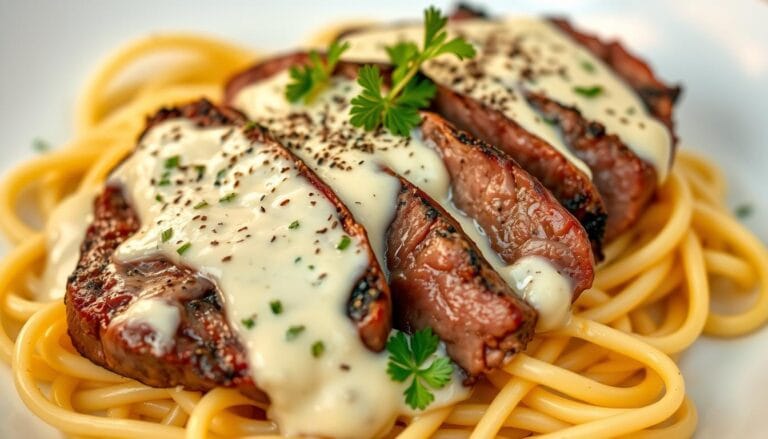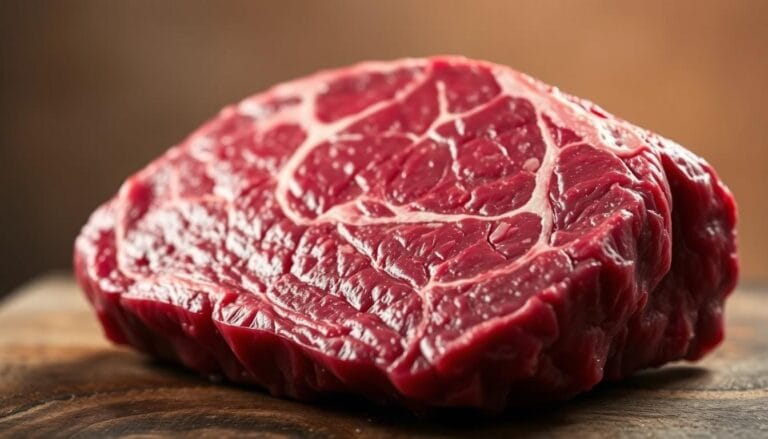How to Cook Picanha Perfectly: Juicy, Tender & Full of Flavor
Table of Contents
How to Cook Picanha Perfectly: Juicy, Tender & Full of Flavor
Imagine biting into a picanha steak that’s so tender it just melts. It’s full of rich, beefy flavor. Picanha is a prized cut from South America, loved for its taste and tenderness. It’s a favorite among steak lovers. Whether you’re a pro chef or a home cook, learning to cook picanha can boost your skills and wow your guests.
Cooking picanha right takes some skill, but with the right tips, you can make it like a pro at home. This guide will show you how to pick the best cut, prep it, and cook it to bring out its flavor.
Key Takeaways
- Understand the characteristics of picanha and its appeal.
- Learn how to select the perfect picanha cut.
- Discover various cooking methods for picanha.
- Master techniques for achieving tender and flavorful results.
- Impress your guests with a perfectly cooked picanha.
What is Picanha?
Picanha is a key part of Brazilian food, loved for its taste and softness. It comes from the top of the rump, with a fat cap. This fat cap is key because it melts while cooking, adding flavor and juiciness.
Understanding the Cut
Picanha comes from the cow’s rump cap, a part that’s naturally tender. It has a thick fat layer on one side. This fat layer makes the meat taste better and stay moist while cooking.
Flavor Profile
The taste of picanha is rich and beefy. The fat cap is key to its juiciness. When cooked, the fat melts inside, making the meat juicy and full of flavor.
Popular Cooking Styles
Picanha is best cooked with high heat, like grilling. This makes the outside crispy and the inside juicy. In Brazil, it’s grilled on skewers, a method called churrasco-style grilling. This method crisps the fat, making the flavor even better. You can also roast or cook it sous vide for different tastes.
Choosing the Right Picanha
To make a great picanha dish, start with the right cut. The quality and type of picanha you choose matters. It affects how your dish turns out, whether you grill, roast, or cook it sous vide.
Grass-Fed vs. Grain-Fed
The way cattle are fed changes the taste and feel of your picanha. Grass-fed picanha is leaner and has a stronger beef taste. On the other hand, grain-fed picanha is fattier, making it tender and juicy. Think about what you like in flavor and texture to choose.
- Grass-Fed: Leaner, more intense beef flavor, potentially less tender.
- Grain-Fed: Fattier, tender, and juicier, with a milder flavor.
USDA Grading
The USDA grading system shows the quality of your picanha. Grades like Prime, Choice, and Select show marbling, tenderness, and quality. For home cooking, USDA Choice is a good pick. It’s a balance of quality and price.
- Prime: Highest level of marbling, very tender and flavorful.
- Choice: High quality with moderate marbling, a good balance between tenderness and flavor.
- Select: Leaner, less marbling, and potentially less tender.
Size and Thickness Considerations
The size and thickness of your picanha matter for cooking. A 2-3 pound picanha is usually best for most methods. Choose a thickness for even cooking. A thicker cut gets a nice crust outside and stays juicy inside.
When buying picanha, look for a good fat cap. It makes the meat taste better and feel tender. The meat should be a bright red color and firm to the touch. Your butcher can help pick the best cut for you.
Essential Tools for Cooking Picanha
To cook picanha perfectly, you need a few key tools. Cooking picanha steaks requires precision and the right tools. This brings out the best flavor and texture.
Grill Options
There are several grilling options: gas, charcoal, or pellet grills. Each has its own benefits. Gas grills give precise temperature control, which is key for cooking picanha right. Charcoal grills add a smoky flavor that many love. Pellet grills offer both temperature control and smoky flavor.
| Grill Type | Temperature Control | Flavor Profile |
|---|---|---|
| Gas Grill | High | Clean, Neutral |
| Charcoal Grill | Medium | Smoky, Rich |
| Pellet Grill | High | Smoky, Complex |
Precision with a Meat Thermometer
A meat thermometer is key for perfect picanha doneness. An instant-read digital thermometer is best for its accuracy and speed.
The internal temperature for picanha varies by doneness. Rare is 130°F – 135°F, medium is 140°F – 145°F, and well-done is above 160°F.
The Importance of a Sharp Knife and Cutting Board
A sharp knife and a sturdy cutting board are vital for picanha prep and serving. A sharp carving knife is great for slicing against the grain, making the meat tender.
Other helpful tools include grill baskets, cast iron skillets, and butcher’s twine for certain methods.
With these essential tools, you’ll be ready to cook delicious picanha. It will be juicy and full of flavor.
Preparing Your Picanha
Before cooking your picanha, it’s key to prepare it right. This brings out its full flavor. Several steps are important for a great dining experience.
Trimming the Fat Cap
The fat cap on your picanha adds flavor and tenderness when cooked right. Trim it to 1/4 to 1/2 inch thick. This ensures the fat renders well, avoiding flare-ups and keeping it juicy.
Use a sharp knife to score the fat cap in a crosshatch pattern. This helps the fat render better and lets seasonings get deeper into the meat. But be careful not to cut too deep, as this can dry out the meat.
Seasoning Options
Traditional Brazilian cuisine uses coarse salt, or “sal grosso,” to enhance the meat’s natural flavors. But you can also try other seasonings to add to the beef’s rich taste. Mix garlic, herbs, and spices for more depth and complexity.
Here are some seasoning ideas:
- Garlic and black pepper for a classic taste
- Herbs like thyme and rosemary for a more aromatic flavor
- Spicy seasonings such as chili powder or paprika for a bold kick
Marinating vs. Dry Rubs
There’s a debate between marinating and using dry rubs. Marinating involves soaking the picanha in a liquid mix of vinegar, oil, and spices. It adds moisture and flavor. Dry rubs, on the other hand, apply spices and herbs directly to the meat, creating a flavorful crust.
Many prefer a simple salt-based dry rub for picanha, as it highlights the meat’s natural flavor. But if marinating, don’t overdo it to avoid making the meat mushy. A balanced approach is best.
“The art of cooking is not just about following a recipe; it’s about understanding the ingredients and techniques that bring out the best flavors.” – Chef’s wisdom
How to Cook Picanha on the Grill
To grill picanha perfectly, you need to balance direct and indirect heat. Grilling is a key method in Brazilian cuisine, often used in rodizio.
Direct vs. Indirect Heat
Setting up a two-zone fire on your grill is key for picanha. Start by searing the picanha over high direct heat (around 450-500°F) to get a flavorful crust. This initial sear should be quick, 2-3 minutes per side, to keep the juices in.
After searing, move the picanha to indirect heat to finish cooking. This step is vital for the right doneness without burning the outside. Adjust cooking time for larger cuts.
Cooking Times and Techniques
Cooking times depend on picanha thickness and desired doneness. Cook with the fat cap up to let the fat render and baste the meat.
For a 1-inch thick picanha, cooking times range from 10 to 20 minutes after searing. Use a meat thermometer to check for internal temperatures: 130-135°F for medium-rare, 140-145°F for medium, and 160°F or higher for well-done.
Recommended Grill Settings
Temperature control is essential when grilling picanha. For gas grills, preheat to high heat for searing, then to medium-low for indirect cooking. For charcoal grills, ensure coals are evenly distributed for consistent heat.
The traditional Brazilian method cooks picanha on skewers in a C-shape. But you can also cook it flat for even doneness. Keep the grill lid closed to maintain temperature and ensure even cooking.
Cooking Picanha in the Oven
For those without outdoor grilling space, cooking picanha in the oven is a great option. It results in a tender interior and a crispy, flavorful crust. Follow these steps for prepping, roasting, and finishing your picanha.
Prepping and Preheating
Start by heating your oven to 425°F (220°C). While it heats up, pat your picanha dry with paper towels. This helps create a good crust. Let the meat sit at room temperature for about 30 minutes for even cooking.
Use a heavy roasting pan or a cast iron skillet for cooking. These pans hold heat well and help achieve a great sear. Season the picanha with your favorite spices and herbs.
Roasting Techniques
There are two main ways to roast picanha in the oven: the reverse sear method and the traditional sear-first approach.
- Reverse Sear Method: Start by slow-roasting the picanha until it reaches your desired internal temperature. Then, sear it on the stovetop or under the broiler for a crispy crust.
- Sear-First Approach: Begin by searing the picanha on the stovetop in a hot skillet to get a nice crust. Then, finish it in the oven until it reaches the desired doneness.
| Cooking Method | Oven Temperature | Internal Temperature | Cooking Time |
|---|---|---|---|
| Reverse Sear | 275°F (135°C) | 130°F – 135°F (54°C – 57°C) for medium-rare | 1-2 hours depending on size |
| Sear-First | 425°F (220°C) | 130°F – 135°F (54°C – 57°C) for medium-rare | 15-30 minutes after searing |
Achieving the Perfect Crust
To get a flavorful crust, start by searing the picanha on the stovetop. Then, finish it under the broiler for a few minutes. Basting with butter during the last few minutes adds richness and flavor.
Use a meat thermometer to check the internal temperature. For medium-rare, aim for 130°F to 135°F (54°C to 57°C).
Sous Vide Picanha: A Modern Approach
Sous vide cooking is a precise way to cook picanha perfectly. You seal the meat in bags and cook it in a water bath at a set temperature. This method ensures even cooking, so your picanha is just right all the way through.
Advantages of Sous Vide for Picanha
The sous vide method cooks the meat slowly, making it tender and juicy. It prevents overcooking, which can dry out picanha. The result is a tender and juicy piece of meat that’s full of flavor.
Temperature Settings for Sous Vide Picanha
Choosing the right temperature is key for great results. Here are some guidelines for different doneness levels:
- Rare: 129°F (2-4 hours)
- Medium-rare: 134°F (2-4 hours)
- Medium: 140°F (2-4 hours)
You can adjust the cooking time based on the thickness of your picanha and your personal preference.
Finishing Techniques for Sous Vide Picanha
After sous vide cooking, it’s important to finish the picanha right. Start by pat-drying the meat to remove excess moisture. Then, use a high-heat method like searing in a cast iron pan, using a torch, or grilling briefly to add a crust. Resting the meat before slicing is key to keep it tender and flavorful.
Also, remember food safety when cooking sous vide. Make sure your picanha is sealed well to prevent contamination. Always refrigerate or freeze it promptly after cooking.
Cooking Picanha in a Skillet
Don’t have a grill or oven? Cooking picanha in a skillet is a tasty solution. It creates a crispy outside and a juicy inside.
Choosing the Right Pan
The right pan is key for skillet-cooked picanha. Choose a heavy pan like cast iron or carbon steel. They hold heat well and can get hot enough for a great sear. Non-stick pans can’t handle the heat needed for a perfect crust.
- Cast Iron: Keeps heat well and sears evenly.
- Carbon Steel: Heats up fast and sears well.
Searing for Flavor
Searing is vital for a flavorful crust. Heat your skillet to medium-high or high. Don’t touch the meat too much to keep the crust even. Add garlic, thyme, or rosemary for extra taste. Try the butter basting technique for extra richness.
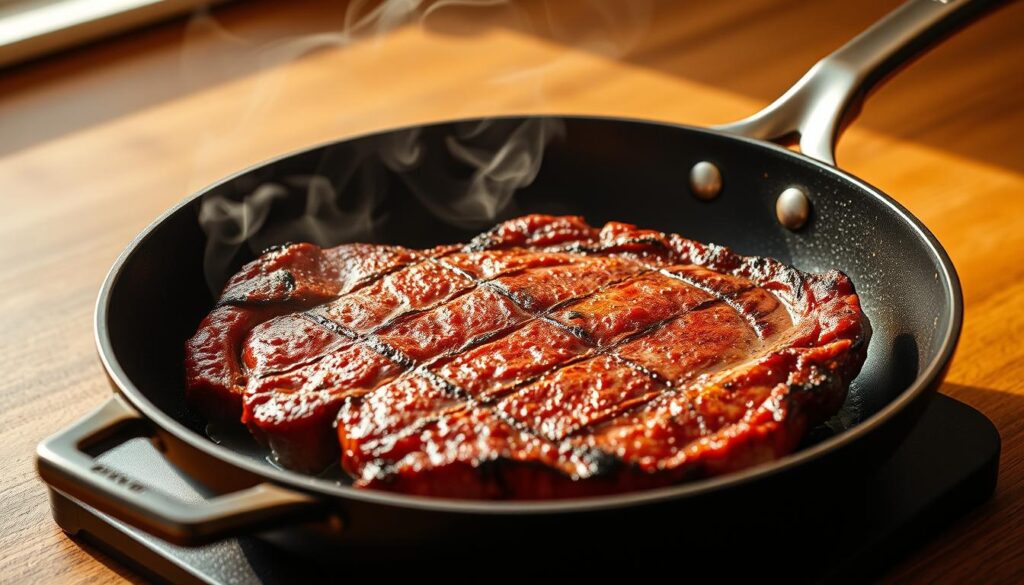
Deglazing and Making Sauce
After searing, you’ll have a pan full of tasty browned bits. Deglazing with wine, stock, or broth makes a great sauce. Pour in the liquid, scrape the bottom, and then reduce it to concentrate the flavors. For a creamy sauce, add butter later.
- Deglaze the pan with your chosen liquid.
- Scrape the bottom to release the browned bits.
- Reduce the liquid to your desired consistency.
- Finish with butter for a creamy sauce.
Serving Suggestions for Picanha
Mastering picanha cooking is just the start. Now, think about how to serve it for a memorable meal. The right slicing, side dishes, and drinks can make your meal stand out.
Slicing Techniques
Slicing picanha right is key for tenderness and looks. Always cut against the grain for tender bites. Look for lines on the meat to find the grain.
Slice it into thin strips, about 1/4 to 1/2 inch thick. This balance of texture and ease makes every bite perfect.
Pairing with Side Dishes
Picanha’s flavor goes well with many sides, from Brazilian to international. For a true Brazilian taste, try it with farofa, vinagrete, or pão de queijo. Or, go global with chimichurri sauce, roasted veggies, or potatoes.
- Farofa
- Vinagrete
- Pão de queijo
- Chimichurri sauce
- Roasted vegetables
- Potato preparations
Ideal Wine and Beverage Pairings
Choosing the right drink can make your meal better. Full-bodied red wines like Malbec or Cabernet Sauvignon pair well. Craft beers with a malty or hoppy taste also work great.
For a Brazilian twist, try caipirinha, a mix of cachaça, sugar, and lime.
- Brazilian Malbec
- Argentine Malbec
- Cabernet Sauvignon
- Craft beers
- Caipirinha
Storing Leftover Picanha
Properly storing leftover picanha is key to keeping it tasty and safe. Whether you cooked a whole picanha or just a few slices, following the right steps ensures you can enjoy it again. This way, you won’t lose any flavor or compromise on food safety.
Refrigerating Cooked Picanha
To keep cooked picanha fresh in the fridge, cool it down fast and use airtight containers. Wrap it in butcher paper or foil, or use containers to keep moisture out. Cooked picanha stays good in the fridge for 3 to 4 days.
Tips for Refrigeration:
- Cool the picanha to room temperature within two hours of cooking.
- Use shallow containers to help it cool faster.
- Label the containers with the date you stored it.
Freezing Picanha for Longer Storage
Freezing is a great way to keep your picanha fresh for longer. You can freeze both raw and cooked picanha. For raw picanha, wrap it in plastic or foil and then in a freezer-safe bag. For cooked picanha, slice it first and wrap it in airtight packaging or freezer bags to avoid freezer burn.
Freezing Tips:
- Portion the picanha into manageable sizes before freezing for easier thawing.
- Use vacuum sealing to remove air and prevent freezer burn.
- Label the packages with the date and contents.
- Store in the freezer at 0°F (-18°C) or below.
Cooked picanha can be frozen for up to 2-3 months for the best quality. When you’re ready to eat it, thaw it overnight in the fridge.
Reheating Leftover Picanha
Reheating picanha needs care to avoid it becoming overcooked or dry. The trick is to reheat it gently. You can use a sous vide machine to reheat it to the right temperature without overcooking. Or, you can warm it in a low-temperature oven with some moisture, or quickly reheat it on the stovetop with a bit of fat.
Reheating Options:
- Sous vide reheating: Seal the picanha in a bag and reheat at 130°F – 135°F (54°C – 57°C).
- Oven reheating: Warm it in a covered dish at 275°F (135°C) with some broth or sauce.
- Stovetop reheating: Quickly reheat slices in a skillet with butter or oil over low heat.
Getting creative with leftover picanha can be fun. You can make picanha sandwiches, add it to salads, use it in tacos, or mix it into stir-fries. Picanha’s versatility makes it a great leftover to have on hand.
Common Mistakes to Avoid
Getting a perfectly cooked picanha can be tricky. But, knowing what to avoid can help a lot.
Overcooking Your Meat
Picanha can get tough if it’s overcooked. It’s important to use a meat thermometer. This helps you cook it just right, so it stays juicy and tender.
Not Letting it Rest
Not letting picanha rest can make it less tasty. Resting lets the juices to redistribute, making it tender and flavorful. For picanha, rest it for 10-15 minutes, depending on its size.
Skipping Flavor Enhancements
Picanha tastes great on its own, but proper seasoning is key. Skipping or overdoing it can mess up the flavor. The right seasoning brings out the best in your picanha.
Other mistakes include improper fat cap management, slicing the wrong way, and cooking cold meat. Being careful about these can make your picanha experience better.
Understanding Doneness Levels
Knowing the different doneness levels is key to cooking picanha perfectly. Getting the right doneness makes your picanha tender and flavorful.
Rare vs. Medium vs. Well-Done
Picanha can be cooked to various levels, each with its own taste. The internal temperature ranges are: rare (125-130°F), medium-rare (130-135°F), medium (135-145°F), medium-well (145-155°F), and well-done (155°F+). For the best taste, cook picanha medium-rare to medium.
- Rare: 125-130°F, red and juicy center
- Medium-rare: 130-135°F, warm red center
- Medium: 135-145°F, hint of pink in the center
- Medium-well: 145-155°F, slightly pink center
- Well-done: 155°F+, fully cooked with no pink color
How to Use a Meat Thermometer
A meat thermometer is essential for perfect doneness. To use it, insert the thermometer into the thickest part of the picanha, avoiding fat or bone. There are two types: instant-read and leave-in probe thermometers.
Instant-read thermometers give quick readings. Leave-in thermometers let you monitor continuously.
Visual Cues for Doneness
While a thermometer is best, visual cues can also help. The finger test checks the meat’s firmness: soft for rare, springy for medium-rare, and hard for well-done. The color of juices also shows doneness: red for rare, pink for medium, and clear for well-done.
But, the fat cap on picanha can make it hard to see. Remember, the meat will cook a bit more after it’s removed from heat.
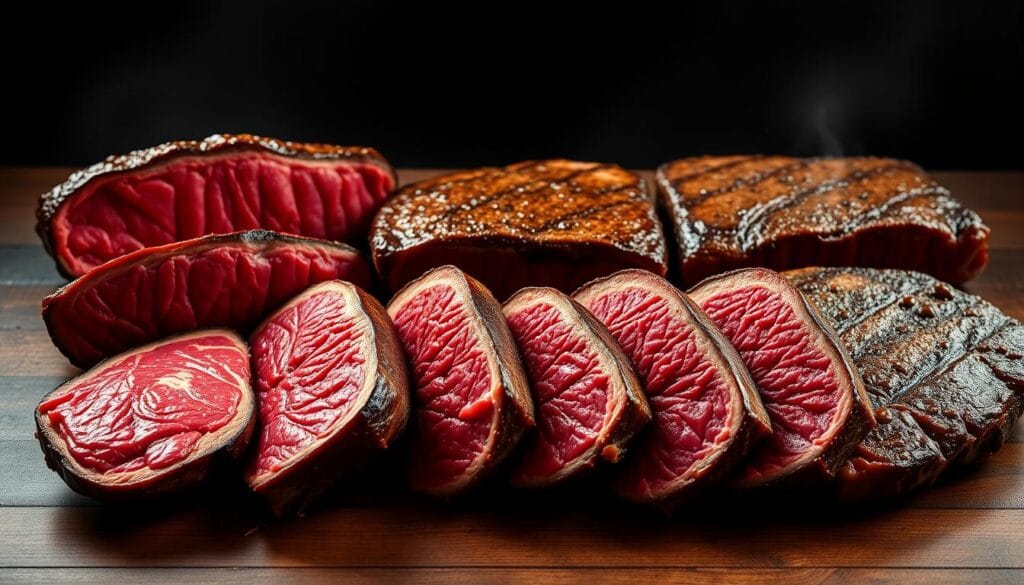
Tips for the Perfect Cook
To cook your picanha perfectly, pay close attention to detail and use expert techniques. First, make sure to prepare your meat right before cooking.
Allowing the Meat to Come to Room Temp
Letting your picanha warm up to room temperature before cooking is key. This step, called “tempering,” helps the meat cook evenly. Remove it from the fridge and let it sit for 30 to 60 minutes before cooking.
This method ensures even cooking and better browning. But, don’t leave the meat out too long to keep it safe.
Importance of Resting
Resting your picanha after cooking is as important as cooking it. When you cook meat, the fibers contract, pushing juices to the surface. Letting it rest allows these juices to spread evenly, making the meat tender and juicy.
Rest it for 10 to 15 minutes after cooking. You can cover it with foil to keep it warm, but this might affect the crust. Choose whether to cover it based on what you value more: a tender inside or a crispy outside.
Flipping Techniques
Flipping your picanha is an art that changes with the cooking method. Pan-searing needs frequent flipping for an even crust, while grilling might need less turning for a nice char. Always handle the meat gently to keep it moist and the fat cap to render well.
Try basting with pan drippings or melted fat to boost flavor and texture. To improve your picanha cooking, manage your grill’s heat zones. This helps with uneven cuts. By mastering these techniques, you’ll cook a picanha that will wow everyone.
Flavor Enhancements
Learn how to boost your picanha’s flavor with our expert tips. Picanha is known for its rich beef taste. But, there are many ways to make it even better without losing its natural flavor.
Using Wood Chips for Smoking
Smoking gives picanha a unique flavor. Different wood chips can change the taste.
- Hickory: Strong, sweet, and smoky, perfect for a bold flavor.
- Oak: Offers a smooth, subtle smokiness, great for balancing picanha’s richness.
- Mesquite: Has a strong, earthy taste, use it sparingly to avoid overpowering.
- Fruitwoods (like Cherry): Adds a fruity and sweet flavor, ideal for a light smoke taste.
To smoke wood chips, soak them in water for 30 minutes before grilling. For gas grills, use a smoke pouch to keep the chips contained.
Adding Herbs and Spices
Herbs and spices can really enhance picanha’s taste. Traditional Brazilian cooking often uses simple seasonings like rock salt.
“The beauty of picanha lies in its simplicity, but the right seasoning can elevate it to new heights.”
Here are some seasoning options:
| Seasoning | Description |
|---|---|
| Garlic and Black Pepper | A classic mix that adds depth without overpowering the meat. |
| Paprika and Rosemary | Offers a smoky and herbaceous flavor. |
| Thyme and Lemon | Brings a bright, citrusy note to balance the richness. |
Sauces and Marinades Recommendations
Sauces and marinades can add more flavor to your picanha. Try traditional Brazilian sauces like chimichurri and vinagrete.
- Chimichurri: A tangy, herby sauce with parsley, oregano, garlic, red pepper flakes, vinegar, and olive oil.
- Brazilian Vinagrete: A fresh, tangy sauce with tomatoes, onions, bell peppers, vinegar, and olive oil.
When making marinades, keep it balanced. Avoid acidic or salty marinades that can hide the picanha’s natural taste.
Cooking Picanha for Special Occasions
Cooking picanha is a great way to impress your guests. This premium beef cut makes any celebration unforgettable.
Occasions that Shine with Picanha
Picanha is perfect for many special occasions. It’s great for summer barbecues, holiday gatherings, or intimate dinner parties. When planning, think about how many guests you’ll have. For big groups, you might need to cook more picanha or add other dishes.
- Summer barbecues and outdoor gatherings
- Holiday celebrations like Christmas or Easter
- Special occasions such as anniversaries or birthdays
- Family reunions or large dinner parties
Presentation Matters: Family-Style vs. Plated
How you present your picanha can change the dining experience. You can serve it family-style or plated individually. Brazilian rodizio-style carving adds a theatrical touch, while plated presentations are more elegant.
For family-style, slice the picanha thinly and arrange it on a large platter. Add fresh herbs and sides. For plated service, slice it into individual portions and add accompaniments.
Creating an Unforgettable Experience
To make the experience memorable, build a themed meal around your picanha. Add Brazilian-inspired appetizers like coxinha or empanadas. Serve with grilled vegetables or rice and beans. Choose drinks like Caipirinhas or a rich red wine.
Telling the story of picanha can enrich the meal. Share its cultural significance in Brazilian cuisine. This turns dinner into a special experience.
To avoid stress, plan ahead. Make a timeline for prep and cooking. This way, you can relax and enjoy the evening with your guests.
Conclusion: Enjoying Your Picanha
Cooking picanha is a rewarding experience. It combines technique, patience, and creativity. Keep a record of your preparations to improve your skills over time. Note the cooking times, temperatures, and seasoning combinations that work best for you.
Refining Your Technique
Try different methods, like cooking picanha in the oven. This can make your dish tender and flavorful. Learning about picanha and its unique qualities will enhance your appreciation for this Brazilian beef cut.
Sharing the Experience
Picanha is best enjoyed with family and friends. As you get better at cooking it, share your knowledge and creations. This can create lasting traditions and memories.
Exploring New Flavors
Don’t be afraid to try new flavors and techniques. Whether it’s a different seasoning or cooking method, the journey is as important as the end result. Embracing culinary exploration will help you grow as a cook and enjoy the rewards of cooking picanha.
FAQ
What is picanha?
How do you cook picanha?
What is the ideal temperature for cooking picanha?
How do you achieve a perfect crust on picanha?
Can you cook picanha in the oven?
How long should you rest picanha after cooking?
What are some recommended side dishes for picanha?
How do you slice picanha correctly?
Can you freeze cooked picanha?
What are common mistakes to avoid when cooking picanha?
For more cooking tips, stay connected with us. We also recommend the cookbook Skinnytaste Simple: Easy, Healthy Recipes with 7 Ingredients or Fewer
For more Recipes about Steak ?
Did You try our recipe ?
There are no reviews yet. Be the first one to write one.
